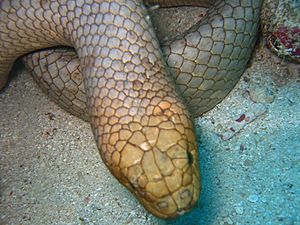Aipysurus laevis facts for kids
Quick facts for kids Aipysurus laevis |
|
|---|---|
 |
|
| Conservation status | |
| Scientific classification | |
| Genus: |
Aipysurus
|
| Species: |
laevis
|
The olive sea snake (Aipysurus laevis) is a type of venomous sea snake. You can find it in the warm waters of the Indo-Pacific Ocean. It's also known as the golden sea snake or olive-brown sea snake.
Contents
About the Olive Sea Snake
The olive sea snake uses its special paddle-like tail to swim. Its back and sides are brownish and purple. Its belly is a white color. These snakes can grow up to one meter long. Some can even reach two meters!
While they can be aggressive when hunting, they usually don't attack divers or larger animals. However, if they feel threatened, they will defend themselves. Sharks and ospreys are the main animals that hunt the olive sea snake.
Where They Live and What They Eat
This snake is very common and lives in many places. You can find it on coral reefs, including the famous Great Barrier Reef. They also live in parts of the north-western Atlantic and north-eastern Pacific Oceans.
When not hunting or breathing, they hide in small coves or safe coral spots. They eat crustaceans, fish, and fish eggs. They use their venom to make their prey unable to move. This snake's venom is very strong. It has special enzymes that help break down the prey inside for easier digestion. It also affects the muscles and nerves of the animals they catch. Drop for drop, it is one of the most toxic sea snake venoms.
Olive sea snakes usually hunt in coral reefs. They poke their heads into cracks and holes to find food. They tend to stay away from open water when looking for a meal.
Amazing Skin Senses
Scientists have found that the olive sea snake has special cells in its tail skin. These cells can sense light! This helps the snake make sure its whole body, including its tail, is hidden inside coral holes during the day. While other sea snakes haven't been checked, the olive sea snake might not be the only one with this cool ability. Many different animals have skin that can sense light.
Life Cycle and Young
Male olive sea snakes can start having babies when they are about three years old. Females take a bit longer, usually starting when they are four or five years old.
When it's time to mate, several male snakes might chase one female in the open water. The female carries the babies inside her for about nine months. She usually gives birth to up to five young snakes at a time. Sometimes, in rare cases, she might have ten or eleven babies! These snakes can live for about fifteen years, and sometimes even longer.
Dangers to Olive Sea Snakes
Even though there aren't many natural threats to the olive sea snake, human activities can be dangerous for them. One of the biggest dangers is prawn trawling. This is when large nets are dragged along the ocean floor to catch prawns.
Up to half of the olive sea snakes caught in these nets die. The ones that survive often get hurt. They can die from drowning or being crushed by the heavy nets.
Taxonomy
The olive sea snake was first described by a scientist named Bernard Germain de Lacépède in 1804. He gave it the name Aipysurus laevis.
Another name, Aipysurus jukesii, was given by John Edward Gray. But now, scientists agree that it's the same species as Aipysurus laevis.
There are two main types, or subspecies, of the olive sea snake that scientists recognize.
| Subspecies | Authority | Common name | Geographic range |
|---|---|---|---|
| A. l. laevis | Lacépède, 1804 | olive sea snake | |
| A. l. pooleorum | L.A. Smith, 1974 | Shark Bay sea snake |
The subspecies A. l. pooleorum is sometimes considered its own full species, called A. pooleorum.
Etymology
The name pooleorum honors two Australian fishermen, "W. and W. Poole." They were the ones who collected the very first example of this snake that scientists studied.


